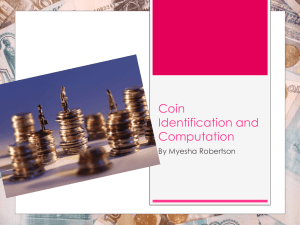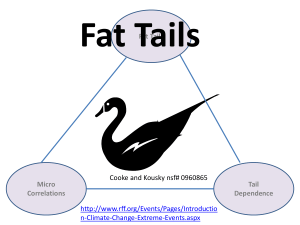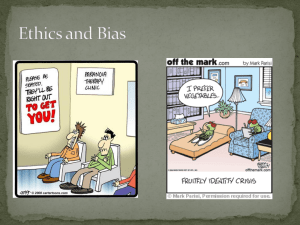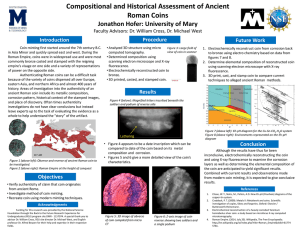Measuring and Estimating Risk Preferences
advertisement
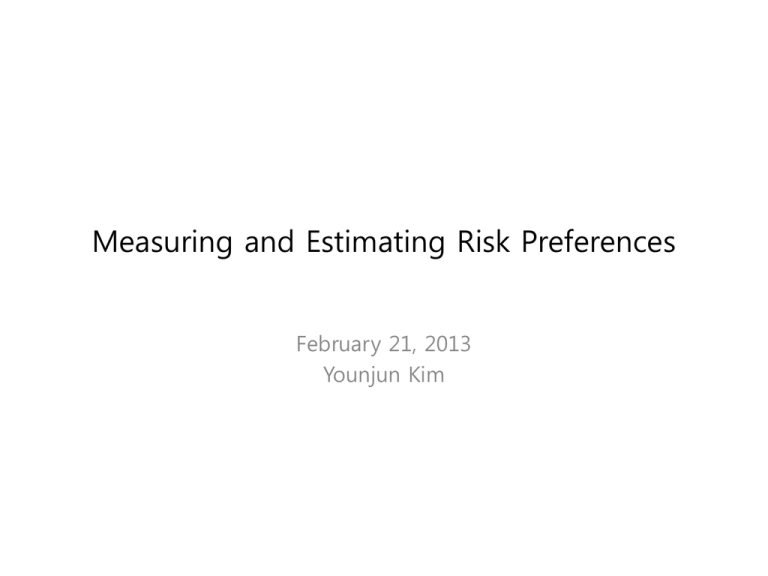
Measuring and Estimating Risk Preferences February 21, 2013 Younjun Kim Outline • Measuring risk preferences – Rankings of risk preferences: rough vs. exact – Who is called risk-averse? – Elicitation methods • Estimating risk preferences – Interval regression – Discrete (binary) choice estimation • Utility Models – – – – – Expected Utility Model Rank-Dependent Utility Model Cumulative Prospect Theory Stochastic reference-dependent utility Model (Koszegi and Rabin, 2006) Application: bias in Multiple Price List elicitation • My know-how about paper-and-pencil survey • References Rankings of risk preferences: rough vs. exact • If you want rough rankings of subjects’ risk preferences, even a simple risk preference question is okay. – eg. health-related behaviors (smoking, drinking, vaccination and BMI) and risk preferences – External validation • If you want exact rankings of subjects’ risk preferences, you need to ask more questions or use more complicated elicitation method. – Eg. group differences of risk preferences (eg. gender and age) – In this case, individual risk preference can be assumed to be a function of gender and age. Who is called risk-averse? • Q1) Which payment do you prefer? – Payment A: $8 if a flipped coin is a head, and $2 if the coin is a tail – Payment B: $10 if a flipped coin is a head, and $0 if the coin is a tail • Suppose that person A has chosen payment A, and that person B has chosen payment B. Who is more risk-averse? • Q2) Which payment do you prefer? – Payment A: $8 if a flipped coin is a head, and $2 if the coin is a tail – Payment B: $10 if a flipped coin is a head, and $1 if the coin is a tail – Payment C: $12 if a flipped coin is a head, and $0 if the coin is a tail • Suppose that person A has chosen payment A, and that person B has chosen payment B. Who is more risk-averse? Who is called risk-averse? (Con’d) • Q3) At least how much would you accept in exchange for the following lottery ticket? – Lottery ticket: $8 if a flipped coin is a head, and $2 if the coin is a tail • Suppose that person A says $2, and that person B says $3. Who is more risk-averse? • Can you believe subjects’ responses? Who is called risk-averse? (Con’d) • To get truthful responses, you can use BDM (Becker-DeGrootMarschak) method or Multiple Price List design. • Subjects may not understand how the BDM method works. Who is called risk-averse? (Con’d) Source: Cason and Plott (Working paper, 2012) Who is called risk-averse? (Con’d) • Multiple price list design is easier to understand than the BDM method, but you need to ask many questions. Source: Sprenger (Working paper, 2010) Elicitation methods • Multiple Price List design – Certainty equivalent, probability equivalent, and Holt and Laury (2002) • Random Lottery Pair design • Ordered Lottery Selection design: Question 2 • BDM (Becker-DeGroot-Marschak, 1964) designs Elicitation methods (Con’d) • Elicitation in Holt and Laury (2002) is commonly used in many studies, which is somewhat more complicated than the ordered lottery selection design. Estimating risk preferences: Interval regression • A dependent variable is an interval at an option where a subject switches from option A to option B. Source: Holt and Laury (2002) Discrete choice estimation with Expected Utility Model • Expected utility of lottery i is defined as following: • Choice probability is defined as below (here we use Probit): • Log-likelihood function is: • For STATA code, refer to Appendix F in Harrison and Rutstrom (2008). Rank-dependent Utility Model • Rank-dependent Utility of lottery i is defined as following: Source: Harrison and Rutstrom (2008) Rank-dependent Utility Model (Con’d) Source: Wakker (2010) Rank-dependent Utility Model (Con’d) Source: Wakker (2010) Rank-dependent Utility Model (Con’d) Source: Wakker (2010) Rank-dependent Utility Model (Con’d) Source: Wakker (2010) Rank-dependent Utility Model (Con’d) Source: Wakker (2010) Cumulative Prospect Theory Source: Wakker (2010) Cumulative Prospect Theory (Con’d) Source: Wakker (2010) Cumulative Prospect Theory (Con’d) • Cumulative Prospect Theory utility (Tversky and Kahneman, 1992) of lottery i is defined as: Source: Harrison and Rutstrom (2010) Koszegi and Rabin (2006) Model • This model is useful when a reference point is stochastic. Source: Sprenger (working paper, 2010) Application: Bias in Multiple Price List Elicitation Payment A: 50% chance of winning $10, and 50% chance of winning $0 Payment B: $3 Payment A: 50% chance of winning $10, and 50% chance of winning $0 Payment B: $1 Payment A: 50% chance of winning $10, and 50% chance of winning $0 Payment B: $2 Payment A: 50% chance of winning $10, and 50% chance of winning $0 Payment B: $3 First Certainty Equivalent MPL: CE1 Q. Which payment do you prefer below? - Payment A: $10 if the flipped coin is a head, and $0 if the flipped coin is a tail - Payment B: $3 I definitely prefer payment A I think I prefer payment A but I am not sure. I think I prefer payment B but I am not sure. I definitely prefer payment B □ □ □ □ Q. 1 2 3 4 5 6 7 8 9 10 If the flipp ed coin is.. . Payment A You rec and If the flipp eive... ed coin is.. . You recei ve… Head Head Head Head Head Head Head Head Head Head $10 $10 $10 $10 $10 $10 $10 $10 $10 $10 $0 $0 $0 $0 $0 $0 $0 $0 $0 $0 Tail Tail Tail Tail Tail Tail Tail Tail Tail Tail Payment B Certain amo unt $1 $2 $3 $4 $5 $6 $7 $8 $9 $10 Check one box I definite I think I prefer ly prefer payment A bu payment t I am not sur A e. □ □ □ □ □ □ □ □ □ □ □ □ □ □ □ □ □ □ □ □ for each row I think I pr I definitel efer payme y prefer p nt B but I a ayment B m not sure. □ □ □ □ □ □ □ □ □ □ □ □ □ □ □ □ □ □ □ □ Note that the table is based on Andreoni and Sprenger (AER, Forthcoming), and that the four response options come form Butler and Loomes (AER, 2007) Second Certainty Equivalent MPL: CE2 Q. Which payment do you prefer below? - Payment A: $8 if the flipped coin is a head, and $0 if the flipped coin is a tail - Payment B: $4 I definitely prefer payment A I think I prefer payment A but I am not sure. I think I prefer payment B but I am not sure. I definitely prefer payment B □ □ □ □ Q. 1 2 3 4 5 6 7 8 If the flipp ed coin is.. . Payment A You rec and If the flipp eive... ed coin is.. . You recei ve… Head Head Head Head Head Head Head Head $8 $8 $8 $8 $8 $8 $8 $8 $0 $0 $0 $0 $0 $0 $0 $0 Tail Tail Tail Tail Tail Tail Tail Tail Payment B Certain amou nt $1 $2 $3 $4 $5 $6 $7 $8 Check one box for each row I definitel I think I pr I think I pr I definitel y prefer p efer payme efer payme y prefer p ayment A nt A but I nt B but I a ayment B am not sur m not sure. e. □ □ □ □ □ □ □ □ □ □ □ □ □ □ □ □ □ □ □ □ □ □ □ □ □ □ □ □ □ □ □ □ Certainty Equivalent MPLs and Single Question CE1: 36 subjects in wave 1 CE2: 38 subjects in wave 1 1 1 0.8 0.8 0.6 0.6 0.4 0.4 0.2 0.2 0 0 $1 $2 $3 $4 $5 $6 $7 $8 $9 $10 $1 $2 $3 $4 $5 $6 $7 $8 Note: Proportions of lottery choices in each decision in MPL (Diamond) and in the selected single question (Square) P-values of Wilcoxon Signed-ranks test Wave CE1 CE2 1 0.008 <0.001 2 0.006 0.004 3 0.058 0.133 Know-how about paper-and-pencil survey • Pretesting – Missing responses – Fine-tuning of questions – Pre-analysis • Recruitment and compensation References • • Becker, G. M.; M. H. DeGroot and J. Marschak. 1964. "Measuring Utility by a Single-Response Sequential Method." Behavioral Science, 9(3), 226-32. Butler, David J. and Graham C. Loomes. 2007. "Imprecision as an Account of the Preference Reversal Phenomenon." The American Economic Review, 97(1), 277-97. • • • • • • Cason, Timothy N and Charles Plott. 2012. "Misconceptions and Game Form Recognition of the Bdm Method: Challenges to Theories of Revealed Preference and Framing." Available at SSRN 2151661. Harrison, Glenn W and E Elisabet Rutström. 2008. "Risk Aversion in the Laboratory," J. C. Cox and G. W. Harrison, Research in Experimental Economics. Bingley: Emerald Group Publishing Limited, Holt, Charles A. and Susan K. Laury. 2002. "Risk Aversion and Incentive Effects." The American Economic Review, 92(5), 1644-55. Kőszegi, Botond and Matthew Rabin. 2006. "A Model of Reference-Dependent Preferences." The Quarterly Journal of Economics, 121(4), 1133-65. Sprenger, Charles. 2010. "An Endowment Effect for Risk: Experimental Tests of Stochastic Reference Points," working paper, Tversky, Amos and Daniel Kahneman. 1992. "Advances in Prospect Theory: Cumulative Representation of Uncertainty." Journal of Risk and Uncertainty, 5(4), 297-323. • Wakker, Peter P. 2010. Prospect Theory: For Risk and Ambiguity. New York: Cambridge University Press.

